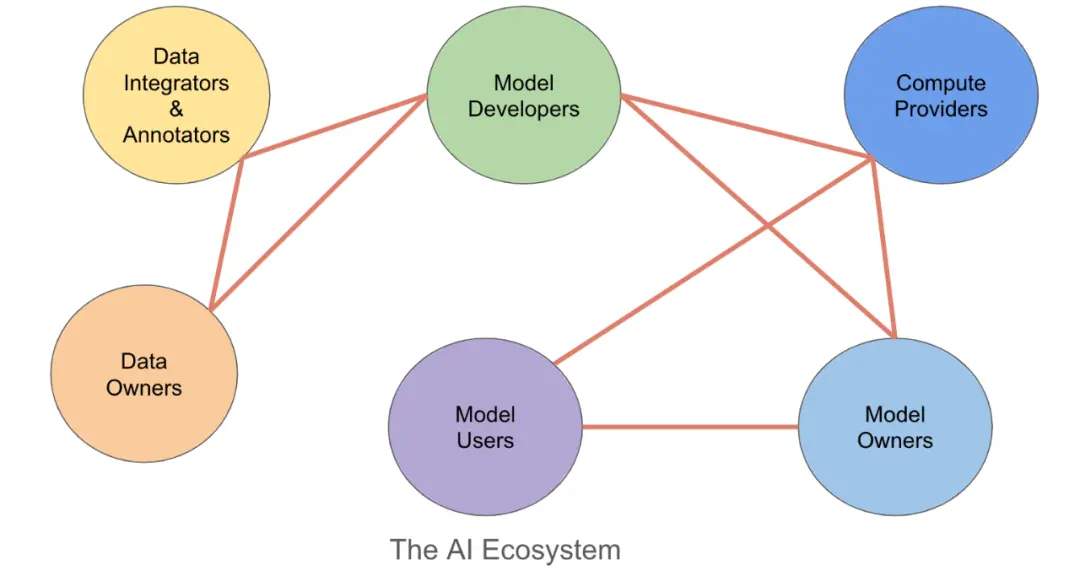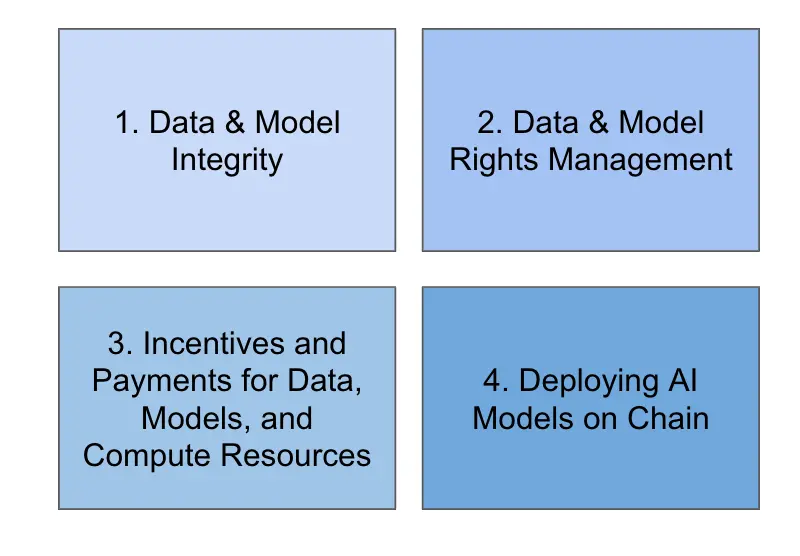Coinbase: Investment and Entrepreneurship Opportunities in AI Blockchain
Original Title: 《Blockchain for AI》
Authors: Rajarshi Gupta, Vijay Dialani
In the past year, we have witnessed explosive growth in the capabilities and applications of artificial intelligence. This includes significant advancements in text-to-image models, the maturity of large language models, and their applications in various business use cases such as search and recommendation, facilitating software development, and big data analysis. It is predicted that by 2032, the generative AI market alone will reach a size of $1.3 trillion, with a compound annual growth rate (CAGR) of 42% over the next decade.
When we explore the intersection of blockchain and artificial intelligence, there are two main aspects to consider. The first is the use of AI/ML models and methods to enhance blockchain platforms, decentralized applications, and the trading of digital on-chain assets. The second, and the main focus of this article, is leveraging the capabilities of blockchain to provide value to developers and users of AI/ML products and services.
Fundamentals of Blockchain Capabilities
There are many fundamental blockchain capabilities that can be utilized for the development, deployment, and operation of AI models. These capabilities encompass cryptographic primitives, blockchain protocols, and smart contracts. They possess the following fundamental attributes, all of which are highly relevant to AI use cases, which we will discuss in the following sections:
Data Security: Helps AI store data in a tamper-proof and immutable manner, achieving high availability through decentralized servers that are less susceptible to attacks, manipulation, censorship, and denial of service.
Data Auditability, Traceability, and Verifiability: Records transactions and assets in an immutable and transparent manner, facilitating the tracking of data provenance, ownership, source, and agreements with digital signatures and timestamps. This also provides auditability and verifiability capabilities.
Decentralized Decision-Making: Enables decisions to be made by multiple entities or directly between parties without an existing trust relationship between them or with a central entity.
Autonomous and Transparent Code Execution: Allows programs to execute as smart contracts that are transparent to all relevant parties and can operate autonomously without relying on trusted and centralized intermediaries.
Decentralized Identity: Provides secure digital identity mechanisms that allow users to interact with services without compromising their privacy.
Micropayments: Offers a secure and lightweight payment method that reduces friction in the payment process.
1. How Blockchain Can Benefit Artificial Intelligence

As shown in the above image, the AI ecosystem has a diverse set of stakeholders that interact with each other regarding data, models, and computational infrastructure. Due to administrative and economic boundaries, there is a certain separation among these potential stakeholders, leading to trust and payment issues that need to be addressed, and blockchain can help solve both of these problems.
We can categorize the potential advantages of blockchain for artificial intelligence, as well as the corresponding products and services that can be developed, into four main categories, as illustrated in the following image. We will discuss these categories one by one below.

2.1. Data and Model Integrity
Blockchain can be used to develop solutions that help users and developers ensure that data and models are not modified without their knowledge.
For example, API-based services can allow data owners and AI developers to record the timestamp hash values of datasets and models to ensure their integrity, and document the entire process of model development and the datasets used, allowing for third-party audits or regulatory oversight. This system could even be directly integrated into ML development tools, such as Pytorch. This can help improve the integrity and trustworthiness of models by making the development process more transparent and secure. It may also be possible to record proof of relevant "orphaned" specific data on the blockchain to demonstrate to regulators that a provider's data has been removed from a given model.
Recording the hash values of on-chain data and model outputs also helps combat deepfakes. For example, applications may be able to ensure the authenticity of the data used by checking the digital signatures associated with on-chain data sources, or a decentralized version of "Snopes.com" could be designed and implemented on the blockchain to flag deepfakes.
2.2. Data and Model Usage and Access Control
Non-fungible tokens (NFTs) can prove someone's ownership of any given digital content or data. Depending on the use case, the content involved can be model inputs, such as prompts for generative AI tools, data used for training models, model parameters, or model outputs.
NFTs would allow users or developers to maintain their ownership and further transfer ownership of the corresponding digital assets to others. A blockchain-based data and model access control mechanism could also be envisioned, such as smart contracts that allow/restrict access based on a given list of user addresses. Alternatively, it could integrate with decentralized identity solutions (potentially using advanced cryptographic techniques like zero-knowledge proofs) to allow access based on certain proven attributes (e.g., allowing access based on proof of user age or only from certain geographical locations) while protecting user privacy.
2.3. Incentives and Payments for Data, Models, and Computational Resources
Blockchain can facilitate low-fee micropayments using stablecoins for the use of generative AI models. Smart contracts can allow for decentralized revenue sharing among multiple co-owners of a model. This co-ownership model is essentially a "decentralized Hugging Face," which may allow small to medium-sized model developers to band together to compete with larger companies in the field. It can also be used to incentivize data providers, data annotators, model developers, or human feedback providers worldwide to join a new decentralized project to develop new generative AI models or solutions, with appropriate mechanisms in place to track contributions so that incentives can be fairly distributed.
Blockchain can also be used to create a decentralized data/model/computation marketplace, enabling computation providers, training data providers, model developers, and users to easily search and match with each other, providing incentives, payments, and contracts and agreements. A blockchain-based decentralized review system implemented using smart contracts can incorporate both automated and human reviewer-based systems to incentivize high-throughput, thorough, and high-quality reviews of data and models.
2.4. On-Chain Deployment of AI
This category involves running certain AI models directly on the blockchain for greater transparency and trust. AI models may directly provide some inference or generation use cases to end users, assuring them that only the models they intend to provide input to can receive the said input and generate the output they see, without manipulation, forgery, or censorship. Alternatively, AI models could be deployed to help smart contracts adjust and optimize their own parameters in response to user transactions.
AI models could also be a smart contract that makes buy/sell/trading decisions for digital assets based on historical and current transaction data on-chain to generate profits. These models can be deployed as smart contracts on Layer 1 chains or through Layer 2 systems (like zk-rollups). These models may be privately owned or decentralized in the form of a DAO, allowing multiple individuals and entities to hold "shares" in a given on-chain model.
In the long run, for such applications, given the high demands of AI applications on data and computation, there may be interest in exploring and developing an entirely new platform to support AI workflows.
3. How We Can Help
Coinbase's mission is to empower economic freedom for over a billion people. As crypto usage grows, we focus on building the most trusted and compliant products and services and supporting other builders. It is clear that artificial intelligence and blockchain align with this strategy, enabling individuals and organizations becoming part of the emerging generative AI ecosystem (which is currently almost entirely based on centralized and insufficiently transparent Web2 frameworks) to benefit from blockchain and chain-based crypto solutions, broadly defined.
We believe Coinbase is particularly well-positioned to be a major contributor in this space because: a) it has significant brand recognition and influence among retail customers and institutional users of blockchain assets and services; b) it has a strong track record of successfully bridging the gap between the emerging Web3 world and existing Web2 systems; c) it has a robust ML development team with a deep understanding of the growing generative AI ecosystem and the needs of developers and other stakeholders.
Coinbase is keen to explore partnerships and integrations with like-minded companies, particularly those with expertise in AI solutions and ecosystem services, and are committed to turning ideas into reality.










